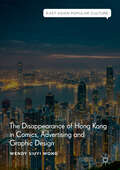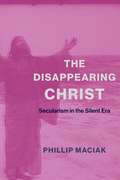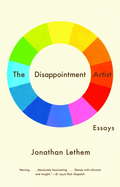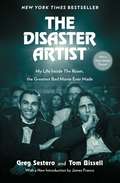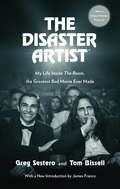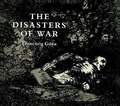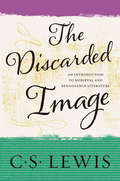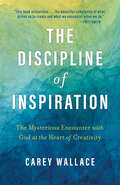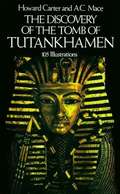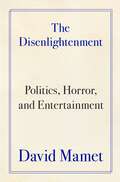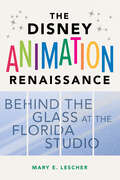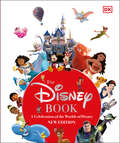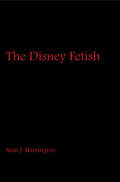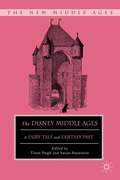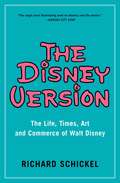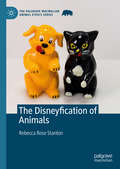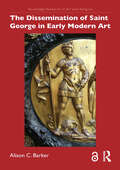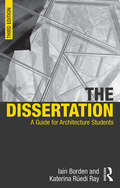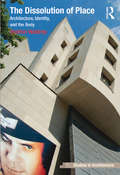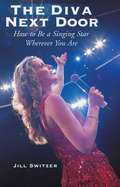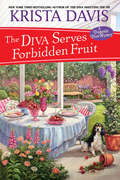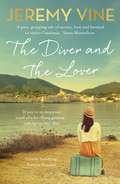- Table View
- List View
The Disappearance of Hong Kong in Comics, Advertising and Graphic Design (East Asian Popular Culture)
by Wendy Siuyi WongThis book examines Hong Kong’s struggle against the disappearance of its unique identity under the historical challenges of colonialism, in addition to the more recent reimposition of Chinese authoritarian government control, as reflected in three under-researched forms of visual media: comics, advertising and graphic design. Each section of the book focuses on one of these three forms, and each chapter focuses on one stage of Hong Kong’s changing cultural identity. The articulative position of this book is on studies of visual cultural history and media communication. Its case studies will broaden readers’ own cultural knowledge for a more international understanding. The Disappearance of Hong Kong in Comics, Advertising and Graphic Design advances the development of its three key subjects in terms of identity, communication and cultural politics, aiming to reach a wide range of multidisciplinary readers.
The Disappearing Christ: Secularism in the Silent Era
by Phil MaciakAt the turn of the twentieth century, American popular culture was booming with opportunities to see Jesus Christ. From the modernized eyewitness gospel of Ben-Hur to the widely circulated passion play films of Edison, Lumière, and Pathé; from D. W. Griffith’s conjuration of a spectral white savior in Birth of a Nation to W. E. B. Du Bois’s “Black Christ” story cycle, Jesus was constantly and inventively visualized across media, and especially in the new medium of film. Why, in an era traditionally defined by the triumph of secular ideologies and institutions, were so many artists rushing to film Christ’s miracles and use his story and image to contextualize their experiences of modernity?In The Disappearing Christ, Phillip Maciak examines filmic depictions of Jesus to argue that cinema developed as a model technology of secularism, training viewers for belief in a secular age. Negotiating between the magic trick and the documentary image, the conflicting impulses of faith and skepticism, the emerging aesthetic of film in this period visualized the fraught process of secularization. Cinematic depictions of an appearing and disappearing Christ became a powerful vehicle for Americans to navigate a rapidly modernizing society. Studying these films alongside a multimedia, interdisciplinary archive of novels, photographs, illustrations, and works of theology, travel writing, and historiography, The Disappearing Christ offers a new narrative of American cultural history at the intersection of cinema studies and religious studies.
The Disappointment Artist: Essays
by Jonathan LethemA mixture of personal memory and cultural commentary, The Disappointment Artist offers a series of windows onto the collisions of art, landscape, and personal history that formed Jonathan Lethem's richly imaginative perspective on life at the end of the twentieth century. Lethem illuminates the process by which a child invents himself as a writer, and as a human being, through a series of approaches to the culture around him. In the title piece, a letter from his aunt (a children's book author) spurs a meditation on the value of writing workshops, the role and influence of reviews, and the uncomfortable fraternity of writers. In 'Defending The Searchers', Lethem explains how a passion for the classic John Wayne Western became occasion for a series of minor humiliations. In 'Identifying with Your Parents', an excavation of childhood love for superhero comics expands to cover a whole range of nostalgia for a previous generation's cultural artefacts. And '13/1977/21', which begins by recounting the summer he saw Star Wars twenty-one times, 'slipping past ushers who'd begun to recognize me. . . ', becomes a meditation on the sorrow and solace of the solitary moviegoer.
The Disaster Artist
by Tom Bissell Greg SesteroFrom the actor who lived through it all and an award-winning narrative nonfiction writer: the inspiring and laugh-out-loud funny story of a mysteriously wealthy social misfit who got past every road block in the Hollywood system to achieve success on his own terms--the making of The Room, "the Citizen Kane of bad movies" (Entertainment Weekly).In 2003, an independent film called The Room--written, produced, directed, and starring a very rich social misfit of indeterminate age and origin named Tommy Wiseau--made its disastrous debut in Los Angeles. Described by one reviewer as "like getting stabbed in the head," the $6 million film earned a grand total of $1,800 at the box office and closed after two weeks. Now in its tenth anniversary year, The Room is an international phenomenon to rival The Rocky Horror Picture Show. Thousands of fans wait in line for hours to attend screenings complete with costumes, audience rituals, merchandising, and thousands of plastic spoons. Readers need not have seen The Room to appreciate its costar Greg Sestero's account of how Tommy Wiseau defied every law of artistry, business, and interpersonal relationships to achieve the dream only he could love. While it does unravel mysteries for fans--who on earth is "Steven," and what's with that hospital on Guerrero Street?--The Disaster Artist is more than just a hilarious story about cinematic hubris. It is ultimately a surprisingly inspiring tour de force that reads like a page-turning novel, an open-hearted portrait of an enigmatic man who will capture your heart.
The Disaster Artist: My Life Inside The Room, the Greatest Bad Movie Ever Made
by Tom Bissell Greg SesteroNow a major motion picture, The Disaster Artist, starring James Franco, Alison Brie, Zoey Deutch, Lizzy Caplan, Zac Efron, Bryan Cranston, Dave Franco, Kristen Bell, Seth Rogen, Sharon Stone, and Judd Apatow.In 2003, an independent film called The Room - starring and written, produced, and directed by a mysteriously wealthy social misfit named Tommy Wiseau - made its disastrous debut in Los Angeles. Described by one reviewer as 'like getting stabbed in the head', the $6 million film earned a grand total of $1,800 at the box office and closed after two weeks. Over a decade later, The Room is an international cult phenomenon, whose legions of fans attend screenings featuring costumes, audience rituals, merchandising and thousands of plastic spoons. In The Disaster Artist, Greg Sestero, Tommy's costar, recounts the film's bizarre journey to infamy, explaining how the movie's many nonsensical scenes and bits of dialogue came to be and unraveling the mystery of Tommy Wiseau himself. But more than just a riotously funny story about cinematic hubris, The Disaster Artist is an honest and warm testament to friendship.
The Disasters of War
by Francisco GoyaThe strikingly original characterizations and sharply drawn scenes that came to be known posthumously as Los Desastres de la Guerra (The Disasters of War) are among Francisco Goya's most powerful works and one of the masterpieces of Western civilization. Goya's model for his visual indictment of war and its horrors was the Spanish insurrection of 1808 and the resulting Peninsular War with Napoleonic France. The bloody conflict and the horrible famine of Madrid were witnessed by Goya himself, or were revealed to him from the accounts of friends and contemporaries. From 1810 to 1820, he worked to immortalize them in a series of etchings.The artist himself never saw the results. The etchings were not published until 1863, some 35 years after his death. By then, the passions of the Napoleonic era had subsided and the satirical implications in Goya's work were less likely to offend. The Dover edition reproduces in its original size the second state of this first edition, which contained 80 prints. Three additional prints not in the 1863 edition are also included here, making this the most complete collection possible of the etchings Goya intended for this series. The bitter, biting captions are reprinted, along with the new English translations, as are the original title page and preface.
The Discarded Image: An Introduction to Medieval and Renaissance Literature
by C. S. LewisIn The Discarded Image, C.S. Lewis paints a lucid picture of the medieval world view, providing the historical and cultural background to the literature of the Middle Ages and Renaissance. It describes the "image" discarded by later years as "the medieval synthesis itself, the whole organization of their theology, science and history into a single, complex, harmonious mental model of the universe." This, Lewis's last book, has been hailed as "the final memorial to the work of a great scholar and teacher and a wise and noble mind."
The Disciplinary Frame: Photographic Truths and the Capture of Meaning
by John TaggPhotography can seem to capture reality and the eye like no other medium, commanding belief and wielding the power of proof. In some cases, a photograph itself is attributed the force of the real. How can a piece of chemically discolored paper have such potency? How does the meaning of a photograph become fixed? In The Disciplinary Frame, John Tagg claims that, to answer these questions, we must look at the ways in which all that frames photography—the discourse that surrounds it and the institutions that circulate it— determines what counts as truth. The meaning and power of photographs, Tagg asserts, are discursive effects of the regimens that produce them as official record, documentary image, historical evidence, or art. Teasing out the historical processes involved, he examines a series of revealing case studies from nineteenth-century European and American photographs to Depression-era works by Walker Evans, Dorothea Lange, and Margaret Bourke-White to the conceptualist photography of John Baldessari. Central to this transformative work are questions of cultural strategy, the growth of the state, and broad issues of power and representation: how the discipline of the frame holds both photographic image and viewer in place, without erasing the possibility for evading, and even resisting, capture. Photographs, Tagg ultimately finds, are at once too big and too small for the frames in which they are enclosed—always saying more than is wanted and less than is desired.
The Discipline of Inspiration: The Mysterious Encounter with God at the Heart of Creativity
by Carey WallaceLearn where inspiration comes from and how to harness it in your life and work. We all know the sensation of inspiration. It&’s what tells a painter what to paint and a singer how to sing—and what prompts us to throw a new spice into an old recipe. But what is inspiration? When we train artists, we typically identify them by their talent and train them in technique. We talk very little about the crucial creative spark of inspiration. Where does it come from? What does it want from us? How can we get more of it? In The Discipline of Inspiration, Carey Wallace meditates on this vital spark and on the ways artists have negotiated with it across genres and throughout history. She also offers practical methods—including silence, community, and rest—to help everyone access more inspiration, more often. Artists will develop a fresh perspective on inspiration and learn new tools for their creative practice. And readers from all walks of life will discover the transformative power of inspiration in every aspect of their lives.
The Discovery of the Tomb of Tutankhamen
by Howard Carter A. C. MaceNovember 4, 1922. For six seasons the legendary Valley of the Kings has yielded no secrets to Howard Carter and his archeological team: "We had almost made up our minds that we were beaten," he writes, "and were preparing to leave The Valley and try our luck elsewhere; and then--hardly had we set hoe to ground in our last despairing effort than we made a discovery that far exceeded our wildest dreams."Join Howard Carter in his fascinating odyssey toward the most dramatic archeological find of the century--the tomb of Tutankhamen. Written by Carter in 1923, only a year after the discovery, this book captures the overwhelming exhilaration of the find, the painstaking, step-by-step process of excavation, and the wonder of opening a treasure-filled inner chamber whose regal inhabitant had been dead for 3,000 years.104 on-the-spot photographs chronicle the phases of the discovery and the scrupulous cataloging of the treasures. The opening chapters discuss the life of Tutankhamen and earlier archeological work in the Valley of the Kings. An appendix contains fully captioned photographs of the objects obtained from the tomb. A new preface by Jon Manchip White adds information on Carter's career, recent opinions on Tutankhamen's reign, and the importance of Carter's discovery to Egyptologists.Millions have seen the stunning artifacts which came from the tomb--they are among the glories of the Cairo Museum, and have made triumphal tours to museums the world over. They are a testament to the enigmatic young king, and to the unwavering tenacity of the man who brought them to light as described in this remarkable narrative.
The Disenlightenment: Politics, Horror, and Entertainment
by David MametOne of America's greatest living literary legends invites you think for yourself in this compelling narrative of manipulation, power, and the human condition. "Government, like Circe, turns men into swine," David Mamet writes in his latest political tour de force. Prepare to be challenged, enlightened, and entertained by The Disenlightenment as Mamet dissects the modern world with enthusiasm, wisdom, and lots of references to movies about the mafia.Once a stalwart of liberal thought, Mamet now turns his penetrating gaze on the cultural milieu that nurtured his artistic growth, revealing how America's elites have twisted our institutions into tools of manipulation. With his one-of-a-kind wit, he exposes the intricate dance between power and myth, unmasking how the elites manipulate media and culture to maintain control.The Disenlightenment fearlessly tackles topics from war to love, success to death, offering a fresh perspective on the human condition. His observations, ranging from the carnival-like nature of politics to the power of language, reflect a society where traditional values are under siege.This book is an opportunity to engage with one of the most provocative and insightful writers of the modern era. Whether you're a long-time Mamet aficionado or new to his work, The Disenlightenment promises to challenge your perceptions, stimulate your mind, and perhaps change how you view the world.
The Disney Animation Renaissance: Behind the Glass at the Florida Studio
by Mary E. LescherWalt Disney Feature Animation Florida opened in Orlando at the dawn of the Disney Renaissance. As a member of the crew, Mary E. Lescher witnessed the small studio’s rise and fall during a transformative era in company and movie history. Her in-depth interviews with fellow artists, administrators, and support personnel reveal the human dimension of a technological revolution: the dramatic shift from hand-drawn cel animation to the digital format that eclipsed it in less than a decade. She also traces the Florida Studio’s parallel existence as a part of The Magic of Disney Animation, a living theme park attraction where Lescher and her colleagues worked in full view of Walt Disney World guests eager to experience the magic of the company’s legendary animation process. A ground-level look at the entertainment giant, The Disney Animation Renaissance profiles the people and purpose behind a little-known studio during a historic era.
The Disney Book New Edition: A Celebration of the World of Disney: Centenary Edition
by Tracey Miller-Zarneke Jim FanningCelebrate more than 100 years of magical Disney storytelling.The ideal gift for Disney, animation, and movie fans! From Snow White and the Seven Dwarfs to Wish, Mary Poppins to The Little Mermaid, Disneyland to Tokyo DisneySea, and fireworks to fan clubs, explore the captivating worlds and creations of Disney and Pixar.Now including more than 50 new pages and updated with ten more years of magic for Disney&’s special 100th anniversary, The Disney Book: New Edition features groundbreaking and record-breaking creations—including Encanto, Moana, and Turning Red—and explores theme parks, experiences, memorabilia, and more. Marvel at beautiful art and artefacts from The Walt Disney Company&’s vast historical collections, and discover live-action and animated movie-making, enchanting parks, and fascinating collectibles. Follow Disney's history using the timeline, and delve into the incredible archives.Perfect for fans who want to know all about the magical worlds of Disney.© 2023 Disney
The Disney Fetish
by Seán J. HarringtonLong considered a figurehead of family values and wholesome adolescence, the Disney franchise has faced increasing criticism over its gendered representations of children in film, its stereotypical representations of race and non-white cultures, and its emphasis on the heterosexual couple. Against a historical backdrop of studio history, audience reception, and the industrial-organizational apparatus of Disney media, Seán Harrington examines the Disney classics through a psychoanalytical framework to explore the spirit of devotion, fandom, and frenzy that is instilled in consumers of Disney products and that underlie the fantasy of the Magic Kingdom. This compelling study demystifies the unsettling cleanliness and pretensions to innocence that the Disney brand claims to hold.
The Disney Middle Ages
by Tison Pugh Susan AronsteinFor many, the middle ages depicted in Walt Disney movies have come to figure as the middle ages, forming the earliest visions of the medieval past for much of the contemporary Western (and increasingly Eastern) imagination. The essayists of The Disney Middle Ages explore Disney's mediation and re-creation of a fairy-tale and fantasy past, not to lament its exploitation of the middle ages for corporate ends, but to examine how and why these medieval visions prove so readily adaptable to themed entertainments many centuries after their creation. What results is a scrupulous and comprehensive examination of the intersection between the products of the Disney Corporation and popular culture's fascination with the middle ages.
The Disney Version: The Life, Times, Art and Commerce of Walt Disney
by Richard Schickel“The single most illuminating work on America and the movies” (The Kansas City Star): the story of how a shy boy from Chicago crashed Hollywood and created the world’s first multimedia entertainment empire—one that shapes American popular culture to this day. When Walter Elias Disney moved to Hollywood in 1923, the twenty-one-year-old cartoonist seemed an unlikely businessman—and yet within less than two decades, he’d transformed his small animation studio into one of the most successful and beloved brands of the twentieth century. But behind Disney’s boisterous entrepreneurial imagination and iconic characters lay regressive cultural attitudes that, as The Walt Disney Company’s influence grew, began to not simply reflect the values of midcentury America but actually shape the country’s character. Lauded as “one of the best studies ever done on American popular culture” (Stephen J. Whitfield, Professor of American Civilization at Brandeis University), Richard Schickel’s The Disney Version explores Walt Disney’s extraordinary entrepreneurial success, his fascinatingly complex character, and—decades after his death—his lasting legacy on America.
The Disneyfication of Animals (The Palgrave Macmillan Animal Ethics Series)
by Rebecca Rose StantonThis book critically examines how Walt Disney Animation Studios has depicted – and sometimes failed to depict – different forms of harming and objectifying non-human animals in their films. Each chapter addresses a different form of animal harm and objectification through the theories of speciesism, romanticism, and the ‘collapse of compassion’ effect, from farming, hunting and fishing, to clothing, work, and entertainment. Stanton lucidly presents the dichotomy between depictions of higher order, anthropomorphised and neotonised animal characters and that of lower-order species, showing furthermore how these depictions are closely linked to changing social attitudes about acceptable forms of animal harm. An engaging and novel contribution to the field of Critical Animal Studies, this book explores the use of animals not only in Disney’s best known animated films such as 101 Dalmatians, but also lesser known features including Home on the Range and Fun and Fancy Free. A quantitative appendix supplying data on how often each animal species appears and the amount of times animal harm or objectification is depicted in over fifty films provides an invaluable resource and addition to scholars working in both Disney and animal studies.
The Dissemination of Saint George in Early Modern Art (Routledge Research in Art and Religion)
by Alison C. BarkerFocusing on England, the German-speaking territories and the Italian peninsula, this book examines how Saint George’s image crossed boundaries and was disseminated.Alison Barker attempts to "dissolve" the boundary of the Alps through examination of images of Saint George, the "travelling" saint. She argues that George’s status as chivalric hero and Christian martyr made him uniquely qualified to cross boundaries in this way, especially through the networks of courts and court culture. Her research demonstrates how the highly recognisable iconography of Saint George’s image meant something different, depending on where he was represented and who was looking at him. Through four case studies that examine how he was depicted and viewed across boundaries of space and media, this book charts a multi-layered cultural network, linking different artists and audiences from three regions. Each case study makes a claim about Saint George and how he acts and is used by four sections of society: rulers, artists, corporate groups and the broad masses.The book will be of interest to scholars working in art history, religious history and Renaissance studies.
The Dissertation: A Guide for Architecture Students (Seriously Useful Guides Ser.)
by Iain Borden Katerina Ruedi RayThe Dissertation is one of the most demanding yet potentially most stimulating components of an architectural course. This classic text provides a complete guide to what to do, how to do it, when to do it, and what the major pitfalls are. This is a comprehensive guide to all that an architecture student might need to know about undertaking the dissertation. The book provides a plain guide through the whole process of starting, writing, preparing and submitting a dissertation with minimum stress and frustration. The third edition has been revised throughout to bring the text completely up-to-date for a new generation of students. Crucially, five new and complete dissertations demonstrate and exemplify all the advice and issues raised in the main text. These dissertations are on subjects from the UK, USA, Europe and Asia and offer remarkable insights into how to get it just right.
The Dissolution of Place: Architecture, Identity, and the Body (Ashgate Studies in Architecture)
by Shelton WaldrepPostmodern architecture - with its return to ornamentality, historical quotation, and low-culture kitsch - has long been seen as a critical and popular anodyne to the worst aspects of modernist architecture: glass boxes built in urban locales as so many interchangeable, generic anti-architectural cubes and slabs. This book extends this debate beyond the modernist/postmodernist rivalry to situate postmodernism as an already superseded concept that has been upended by deconstructionist and virtual architecture as well as the continued turn toward the use of theming in much new public and corporate space. It investigates architecture on the margins of postmodernism -- those places where both architecture and postmodernism begin to break down and to reveal new forms and new relationships. The book examines in detail not only a wide range of architectural phenomena such as theme parks, casinos, specific modernist and postmodernist buildings, but also interrogates architecture in relation to identity, specifically Native American and gay male identities, as they are reflected in new notions of the built environment. In dealing specifically with the intersection between postmodern architecture and virtual and filmic definitions of space, as well as with theming, and gender and racial identities, this book provides provides ground-breaking insights not only into postmodern architecture, but into spatial thinking in general.
The Distributed Workplace: Sustainable Work Environments
by Paul Wheeler Andrew Harrison Carolyn WhiteheadThe Distributed Workplace provides in one volume essential information on sustainable work environments which will be invaluable to those developing workplace strategies for end-user organizations as well as suppliers of office buildings, information and communications technologies and building operation services. Municipal authorities and other organizations concerned with sustainable development and sustainable workplaces will also benefit from this book.
The Diva Next Door: How to Be a Singing Star Wherever You Are
by Jill SwitzerYou too can be a star! If you've ever dreamed of singing on American Idol or grabbing a Grammy Award, The Diva Next Door is for you. Switzer's book, designed for everyone from total novice on up, takes a three-step approach: how to get physically and mentally in shape for a singing career, how to create and fine-tune an act, and how to shine at auditions and to book gigs. Written in the style of a caring girlfriend, the book blends practical information with anecdotes, musical quotes, pep talks, and tips. Sample cover letters, performance agreements, references, and a "diva dictionary" add value. For the hundreds of thousands of female applicants to such shows as American Idol, Nashville Star, Today's Superstar, Oprah and Star Search, and for everyone who has ever dreamed of being a professional singer Written for the complete novice in encouraging girl-to-girl style but packed with information for all levelsAllworth Press, an imprint of Skyhorse Publishing, publishes a broad range of books on the visual and performing arts, with emphasis on the business of art. Our titles cover subjects such as graphic design, theater, branding, fine art, photography, interior design, writing, acting, film, how to start careers, business and legal forms, business practices, and more. While we don't aspire to publish a New York Times bestseller or a national bestseller, we are deeply committed to quality books that help creative professionals succeed and thrive. We often publish in areas overlooked by other publishers and welcome the author whose expertise can help our audience of readers.
The Diva Serves Forbidden Fruit (A Domestic Diva Mystery #14)
by Krista DavisIn the latest Domestic Diva mystery from New York Times bestselling author, Krista Davis, entertaining maven Sophie Winston must cut to the core of another murder investigation when members of an international tour group begin dropping like flies all over Old Town, Virginia . . . With Old Town&’s DIY Home Decorating Festival in full swing, Sophie&’s swamped, juggling a bumper crop of artisans, antique dealers, and decorators for the busy street fair. Still, when her best friend Nina suddenly needs a ride from the airport, Sophie is happy to help . . . until she sees Nina disembarking in a state of disarray. It&’s obvious the trip to Portugal soured somewhere along the way. But after one of Nina&’s traveling companions turns up murdered the following day, Sophie knows something is truly rotten . . . Though the crime scene is staged to look like an accident, Sophie isn&’t fooled and peels off to conduct her own investigation. Her only clue is a strange image the victim scratched into the soil before dying. Could it point to a cryptic killer in Old Town? A bitter travel adversary? Or a cursed artifact smuggled back from the trip? As the mystery grows, so does the body count, and if Sophie doesn&’t pluck the murderer soon, her best friend may be the next to fall . . . Includes delicious recipes and fabulous DIY decorating tips!
The Diver and The Lover: A novel of love and the unbreakable bond between sisters
by Jeremy Vine'The lives of the characters get entangled in this powerful read' WOMAN'S OWN'A pacy, gripping tale of secrets, love and betrayal in 1950s Catalonia, written with skill and colour. It gave me enormous pleasure to read such a satisfying novel.' SANTA MONTEFIORE 'If you're in desperate need of a far-Flung getaway, indulge in this slice of escapist fiction' HEAT'Being transported to a Spanish summer in 1951... I feel the cool of the shadows under the trees and hear the sea as it glistens in the rippling heat. I think you might like it too!' FERN BRITTON'As colourful, rich and mesmerising as one of Dali's paintings, this absorbing, poignant rollercoaster of a read is utterly satisfying and will stay with you long after you've put it down.' PATRICIA SCANLAN 'a tale of intrigue, love, politics and scandal. Mixing fact and fiction The Diver and The Lover keeps up the pace and excitement to the very end.' JOAN BAKEWELL'This tale intrigued me and captured my imagination in equal measure. I loved being whisked back to the 1950s and felt the heat of the Spanish sun as I fell in love with the sisters' unique relationship. Be prepared to be taken on a dramatic journey confronting pain, tragedy and passion along the way ' SARA COX'We'll never look at one of the world's best known paintings in the same way again. [Jeremy Vine] has managed to weave truth and fiction together to bring us a most unexpected love story.' FIONA BRUCE'A touching love story set in General Franco's postwar Spain is hallmark Vine - fresh, well-researchedand packed with female protagonists.' - COUNTRYSIDE MAGSoaked in sunlight, love and the mysteries surrounding a famous artist The Diver and the Lover is a novel inspired by true events.It is 1951 and sisters Ginny and Meredith have travelled from England to Spain in search of distraction and respite. The two wars have wreaked loss and deprivation upon the family and the spectre of Meredith's troubled childhood continues to haunt them. Their journey to the rugged peninsula of Catalonia promises hope and renewal. While there they discover the artist Salvador Dali is staying in nearby Port Lligat. Meredith is fascinated by modern art and longs to meet the famous surrealist. Dali is embarking on an ambitious new work, but his headstrong male model has refused to pose. A replacement is found, a young American waiter with whom Ginny has struck up a tentative acquaintance. The lives of the characters become entangled as family secrets, ego and the dangerous politics of Franco's Spain threaten to undo the fragile bonds that have been forged. A powerful story of love, sacrifice and the lengths we will go to for who - or what - we love.
The Diver and The Lover: A novel of love and the unbreakable bond between sisters
by Jeremy Vine'The lives of the characters get entangled in this powerful read' WOMAN'S OWN'A pacy, gripping tale of secrets, love and betrayal in 1950s Catalonia, written with skill and colour. It gave me enormous pleasure to read such a satisfying novel.' SANTA MONTEFIORE 'If you're in desperate need of a far-Flung getaway, indulge in this slice of escapist fiction' HEAT'Being transported to a Spanish summer in 1951... I feel the cool of the shadows under the trees and hear the sea as it glistens in the rippling heat. I think you might like it too!' FERN BRITTON'As colourful, rich and mesmerising as one of Dali's paintings, this absorbing, poignant rollercoaster of a read is utterly satisfying and will stay with you long after you've put it down.' PATRICIA SCANLAN 'a tale of intrigue, love, politics and scandal. Mixing fact and fiction The Diver and The Lover keeps up the pace and excitement to the very end.' JOAN BAKEWELL'This tale intrigued me and captured my imagination in equal measure. I loved being whisked back to the 1950s and felt the heat of the Spanish sun as I fell in love with the sisters' unique relationship. Be prepared to be taken on a dramatic journey confronting pain, tragedy and passion along the way ' SARA COX'We'll never look at one of the world's best known paintings in the same way again. [Jeremy Vine] has managed to weave truth and fiction together to bring us a most unexpected love story.' FIONA BRUCE'A touching love story set in General Franco's postwar Spain is hallmark Vine - fresh, well-researchedand packed with female protagonists.' - COUNTRYSIDE MAGSoaked in sunlight, love and the mysteries surrounding a famous artist The Diver and the Lover is a novel inspired by true events.It is 1951 and sisters Ginny and Meredith have travelled from England to Spain in search of distraction and respite. The two wars have wreaked loss and deprivation upon the family and the spectre of Meredith's troubled childhood continues to haunt them. Their journey to the rugged peninsula of Catalonia promises hope and renewal. While there they discover the artist Salvador Dali is staying in nearby Port Lligat. Meredith is fascinated by modern art and longs to meet the famous surrealist. Dali is embarking on an ambitious new work, but his headstrong male model has refused to pose. A replacement is found, a young American waiter with whom Ginny has struck up a tentative acquaintance. The lives of the characters become entangled as family secrets, ego and the dangerous politics of Franco's Spain threaten to undo the fragile bonds that have been forged. A powerful story of love, sacrifice and the lengths we will go to for who - or what - we love.
